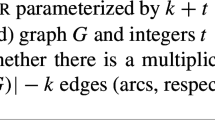Abstract
We study the problem of computing the vitality of edges and vertices with respect to the st-max flow in undirected planar graphs, where the vitality of an edge/vertex is the st-max flow decrease when the edge/vertex is removed from the graph. This allows us to establish the vulnerability of the graph with respect to the st-max flow.
We give efficient algorithms to compute an additive guaranteed approximation of the vitality of edges and vertices in planar undirected graphs. We show that in the general case high vitality values are well approximated in time close to the time currently required to compute st-max flow \(O(n\log \log n)\). We also give improved, and sometimes optimal, results in the case of integer capacities. All our algorithms work in O(n) space.
Access this chapter
Tax calculation will be finalised at checkout
Purchases are for personal use only
Similar content being viewed by others
References
Ahuja, R.K., Magnanti, T.L., Orlin, J.B.: Network Flows (1988)
Ahuja, R.K., Magnanti, T.L., Orlin, J.B., Reddy, M.: Applications of network optimization. In: Handbooks in Operations Research and Management Science, vol. 7, pp. 1–83 (1995)
Alderson, D.L., Brown, G.G., Carlyle, W.M., Cox, L.A., Jr.: Sometimes there is no “most-vital’’ arc: assessing and improving the operational resilience of systems. Mil. Oper. Res. 18, 21–37 (2013)
Altner, D.S., Ergun, Ö., Uhan, N.A.: The maximum flow network interdiction problem: valid inequalities, integrality gaps, and approximability. Oper. Res. Lett. 38, 33–38 (2010)
Ausiello, G., Franciosa, P.G., Lari, I., Ribichini, A.: Max flow vitality in general and st-planar graphs. Networks 74, 70–78 (2019)
Ausiello, G., Franciosa, P.G., Lari, I., Ribichini, A.: Max-flow vitality in undirected unweighted planar graphs. CoRR, abs/2011.02375 (2020)
Balzotti, L., Franciosa, P.G.: Computing lengths of non-crossing shortest paths in planar graphs. CoRR, abs/2011.04047 (2020)
Balzotti, L., Franciosa, P.G.: Max flow vitality of edges and vertices in undirected planar graphs. CoRR, abs/2201.13099 (2022)
Balzotti, L., Franciosa, P.G.: Non-crossing shortest paths in undirected unweighted planar graphs in linear time. J. Graph Algorithms Appl. 26, 589–606 (2022)
Balzotti, L., Franciosa, P.G.: Non-crossing shortest paths in undirected unweighted planar graphs in linear time. In: Kulikov, A.S., Raskhodnikova, S. (eds.) CSR 2022. LNCS, vol. 13296, pp. 77–95. Springer, Cham (2022). https://doi.org/10.1007/978-3-031-09574-0_6
Balzotti, L., Franciosa, P.G.: Non-crossing shortest paths lengths in planar graphs in linear time. In: Mavronicolas, M. (ed.) CIAC 2023. LNCS, pp. xx–yy. Springer, Cham (2023)
Borradaile, G., Klein, P.N.: An \({O}(n \log n)\) algorithm for maximum st-flow in a directed planar graph. J. ACM 56, 9:1–9:30 (2009)
Eisenstat, D., Klein, P.N.: Linear-time algorithms for max flow and multiple-source shortest paths in unit-weight planar graphs. In: Symposium on Theory of Computing Conference, STOC 2013, pp. 735–744. ACM (2013)
Ford, L.R., Fulkerson, D.R.: Maximal flow through a network. Can. J. Math. 8, 399–404 (1956)
Gabow, H.N., Tarjan, R.E.: A linear-time algorithm for a special case of disjoint set union. J. Comput. Syst. Sci. 30, 209–221 (1985)
Hassin, R.: Maximum flow in (s, t) planar networks. Inf. Process. Lett. 13, 107 (1981)
Henzinger, M.R., Klein, P.N., Rao, S., Subramanian, S.: Faster shortest-path algorithms for planar graphs. J. Comput. Syst. Sci. 55, 3–23 (1997)
Itai, A., Shiloach, Y.: Maximum flow in planar networks. SIAM J. Comput. 8, 135–150 (1979)
Italiano, G.F., Nussbaum, Y., Sankowski, P., Wulff-Nilsen, C.: Improved algorithms for min cut and max flow in undirected planar graphs. In: Proceedings of the 43rd ACM Symposium on Theory of Computing, pp. 313–322. ACM (2011)
King, V., Rao, S., Tarjan, R.E.: A faster deterministic maximum flow algorithm. J. Algorithms 17, 447–474 (1994)
Koschützki, D., Lehmann, K.A., Peeters, L., Richter, S., Tenfelde-Podehl, D., Zlotowski, O.: Centrality indices. In: Brandes, U., Erlebach, T. (eds.) Network Analysis. LNCS, vol. 3418, pp. 16–61. Springer, Heidelberg (2005). https://doi.org/10.1007/978-3-540-31955-9_3
Kowalik, L., Kurowski, M.: Short path queries in planar graphs in constant time. In: Proceedings of the 35th Annual ACM Symposium on Theory of Computing, pp. 143–148. ACM (2003)
Łącki, J., Sankowski, P.: Min-cuts and shortest cycles in planar graphs in \({O}({n} \log \log {n})\) time. In: Demetrescu, C., Halldórsson, M.M. (eds.) ESA 2011. LNCS, vol. 6942, pp. 155–166. Springer, Heidelberg (2011). https://doi.org/10.1007/978-3-642-23719-5_14
Mattsson, L.-G., Jenelius, E.: Vulnerability and resilience of transport systems–a discussion of recent research. Transp. Res. Part A: Policy Pract. 81, 16–34 (2015)
Murray, A.T.: An overview of network vulnerability modeling approaches. GeoJournal 78, 209–221 (2013)
Orlin, J.B.: Max flows in \({O}(nm)\) time, or better. In: Symposium on Theory of Computing Conference, STOC 2013, pp. 765–774. ACM (2013)
Phillips, C.A.: The network inhibition problem. In: Proceedings of the Twenty-Fifth Annual ACM Symposium on Theory of Computing, pp. 776–785. ACM (1993)
Ratliff, H.D., Sicilia, G.T., Lubore, S.: Finding the n most vital links in flow networks. Manag. Sci. 21, 531–539 (1975)
Reif, J.H.: Minimum s-t cut of a planar undirected network in \({O}(n\log ^2(n))\) time. SIAM J. Comput. 12, 71–81 (1983)
Wollmer, R.D.: Some Methods for Determining the Most Vital Link in a Railway Network. Rand Corporation (1963)
Wood, R.K.: Deterministic network interdiction. Math. Comput. Model. 17, 1–18 (1993)
Author information
Authors and Affiliations
Corresponding author
Editor information
Editors and Affiliations
Rights and permissions
Copyright information
© 2023 The Author(s), under exclusive license to Springer Nature Switzerland AG
About this paper
Cite this paper
Balzotti, L., Franciosa, P.G. (2023). How Vulnerable is an Undirected Planar Graph with Respect to Max Flow. In: Mavronicolas, M. (eds) Algorithms and Complexity. CIAC 2023. Lecture Notes in Computer Science, vol 13898. Springer, Cham. https://doi.org/10.1007/978-3-031-30448-4_7
Download citation
DOI: https://doi.org/10.1007/978-3-031-30448-4_7
Published:
Publisher Name: Springer, Cham
Print ISBN: 978-3-031-30447-7
Online ISBN: 978-3-031-30448-4
eBook Packages: Computer ScienceComputer Science (R0)




